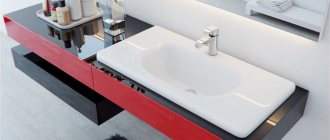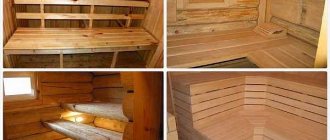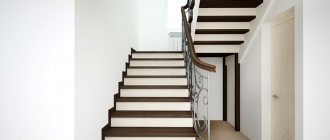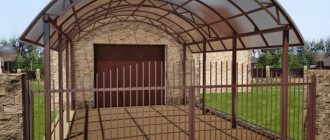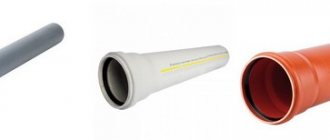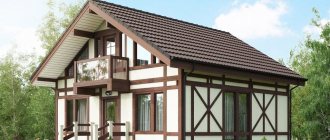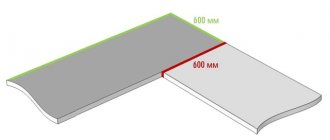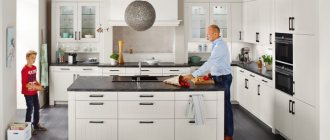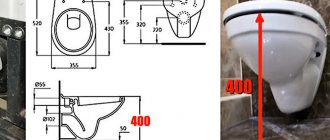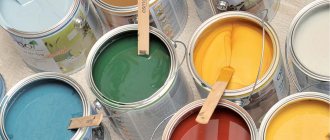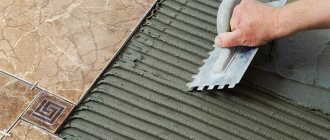The table top is the most important part of this product, since it is used for preparing food or for the process of eating it. It can be made of different materials, and can also have different parameters, shapes and sizes. A tabletop for a computer desk will be significantly different from an element installed on a kitchen product, a decorative structure in a living room, or even on a kitchen set, since each option is influenced by its own factors. That is why, before purchasing, you should find out what types of table tops are available and how they differ.
Dimensions of corner kitchen set
Corner models are practical and functional; they allow you to store a little more dishes and food. They, like other kitchen furniture, have their own standards, compliance with which will make the cooking process more comfortable. Calculation of corner sets:
- the height of the headset varies from 180 to 250 cm;
- the depth of the cabinets should not be less than 30 and more than 50 cm;
- The width of the façade is standard – 30–40 cm.
Despite the clearly marked dimensions, experts still recommend choosing corner models to suit your taste. In this case, they will be the most convenient and practical, which especially applies to non-standard solutions.
Problems due to the characteristics of the premises
In the kitchen you need maximum comfort. This is what the owners want to get, having calculated the dimensions and decided to make do with standard furniture and a tabletop. But when the renovation begins, unpleasant moments suddenly appear. For example, if there are pipes running along the walls that cannot be hidden, the countertop, instead of the usual 60, will have to be 65 cm wide to cover the unsightly addition.
Installation difficulties
Protruding stationary window sills, ducts, and radiators can also become a problem. And then you will have to cut out openings in the furniture and kitchen work surface. This must be done before installing the latter.
Dimensions and base material
When the question arises about purchasing a kitchen set, many people want to have not only a beautiful, but also a unique option. In this case, it is worth considering a nuance: kitchen countertops come in standard sizes and custom-made. The latter can have different sizes and individual shapes; they cost an order of magnitude more. The most common option is to purchase a ready-made set to which the tabletop is fitted. To make the right choice, you should consider the following criteria:
- room area;
- ease of fastening;
- material and its quality characteristics;
- aesthetic appearance.
As a rule, MDF or laminated chipboard is most often used to make countertops. The first option has a thickness of 28 or 38 mm. This also applies to individual orders. This material is inexpensive and comes in many colors. If you need corner countertops, then MDF will not work as the joint is very noticeable. Since this is a natural material, only paraffin or linglin is used for gluing. LDSP is a chipboard that is covered with a layer of laminate. Formaldehyde is used in production
When choosing, you should pay attention to the front edges. If they differ greatly from the place where they were cut, then this is an indicator of low quality
Another popular material for countertops is wood. Planks are made from it and glued together with wood glue. Standard thickness is 18–20 mm or 40 mm. The first option is quite thin, the second is thick. The material can be easily adjusted to the required dimensions. You can choose either solid or laminated board. The choice is based on personal preference, since the quality and service life of the product depend more on the type of wood.
The most expensive material for the production of countertops is considered to be natural stone: granite, marble. Marble stone surface has a thickness of 20–30 mm, it is best to use 26 or 28 mm. Granite countertops are slightly thicker: 30–50 mm. Such a tabletop will add luxury to the interior and introduce a touch of aristocracy. But despite all their beauty, such surfaces quickly become damaged, and some stains simply cannot be removed. Chipboard is used less frequently, since the surface must be moisture resistant. This material is cheap, but of poor quality.
Standards by type of material
First of all, kitchen owners should decide how important a large countertop size is. The kitchen is not only a place for cooking, but also for meeting friends and family gatherings
It is important to maintain comfort and space here. The countertop is the space on which food is prepared, the sink and stove are installed.
There are certain rules here, including compliance with the parameters of the “working triangle”, so that the housewife can cook comfortably.
The dimensions of the tabletop are no less important than, for example, the material for the floor. After all, this is a full-fledged work surface, near which the hostess spends most of her time.
Choosing a ready-made option is easier and more affordable. You will also know in advance how much space the surface will take up and how it will look in your kitchen.
But is everything as good as it might seem at first glance? Standard sizes allow you to immediately get a picture of what your kitchen will look like, how much free space will remain, as well as how to place household appliances and various decorative and general use details on the countertop. On the other hand, this is not always good for large kitchens. If you have space and want to occupy it with something, then standard countertops will not be entirely appropriate here. Non-standard sizes allow you to use all your imagination.
MDF and chipboard
Countertops made of MDF and chipboard are most in demand among consumers. This is due to their low cost. But in terms of wear resistance they are inferior to other materials. Chipboard is compressed sawdust that is joined together using formaldehyde. In fact, this is the same tree, but it is no different in practicality. And formaldehyde is harmful to health.
MDF is a more natural material, so the cost is slightly higher. Paraffin and natural resins are used for joining and pressing. There is also laminated chipboard - this is chipboard covered with a layer of laminated film, which serves as additional protection and increases wear resistance.
The standard sizes of countertops made of this material have the following parameters:
- width (depth) 60, 92 and 120 cm;
- length 4 meters, but some manufacturers prefer 4 m 10 cm, tabletops 3 m long are also in demand;
- thickness from 27 to 40 mm.
Kitchen countertops are made from MDF and chipboard. These are the most inexpensive materials, therefore they are most in demand. The advantage here is the variety of colors and patterns; you can choose a theme specifically for the kitchen.
Wood
A tabletop made of natural wood is not only a stylish solution, but also an environmentally friendly and safe material. For such countertops, oak, pine, larch, beech and ash are used. Manufacturers use the following parameters as standards:
- width – from 600 to 1000 mm;
- length – from 1000 to 3000 mm;
- thickness – up to 40 mm.
The most popular and in demand size is 3000x600 mm. This is convenient for a kitchen of any layout. A wooden tabletop requires some maintenance - regular application of varnish or rubbing in oil. If this is not done, the wood will quickly deteriorate and lose its appearance and practical properties.
Stone
Stone countertops are suitable for large and spacious kitchens. This material is very strong and durable. The tabletop looks expensive and presentable. The most popular size is 4000x600 mm. Standards for stone countertops:
- width – 60 cm;
- length – 75/80/240/300 cm;
- thickness – from 40 mm.
Granite or marble is most often used for countertops. Both materials are very durable, resistant to moisture and mechanical damage. Products are made to order.
Acrylic
Acrylic surfaces are considered to be artificial stone. Its composition is white clay, acrylic shavings and polymers. This material is also very durable and looks great. This countertop will feel warmer to the touch than stone. The size standards are the same as for stone, but the thickness is less. Sometimes it's only 12mm. Due to this, the material consumption is much less, and accordingly the cost will be lower. This thickness does not affect the strength and service life in any way.
Acrylic is a rather difficult material to work with. Its installation is quite expensive, but the result is pleasantly surprising. And special solutions help to effectively mask the seams, creating the effect of a solid canvas. Acrylic often suffers from scratches. Therefore, the material is not suitable for those who sometimes forget to use the board or have small children in the house. But if this happens, then the scratches are easy to restore. Acrylic is not exposed to moisture and does not absorb odors. But, if it comes into contact with acetone, it can be damaged.
Fake diamond
The internal filling of an artificial stone countertop is similar to a plastic one: under the coating there is moisture-resistant chipboard. The top layer of artificial stone ranges from 6 mm to 12 mm. According to manufacturing technology, acrylic and liquid (cast) material are distinguished.
Acrylic coating is made from chips of natural stones with the addition of polymer filler and resins, which are fixed to each other. A durable material with high performance properties is obtained. The thermal characteristics of artificial stone allow it to withstand temperatures of 200°C.
After production, the product is subjected to grinding and polishing. The working surface is sanded after installation, and all joints and seams become invisible. Polishing allows you to make the countertop glossy or leave a matte effect.
Any stains from the surface of the artificial stone are removed with a simple soapy sponge or rag. The material is difficult to damage with acids and other chemicals. It does not absorb oil stains.
An integrated sink made of the same material is often built into the countertop. This sink does not differ in color from the work surface, has no seams at the junction with the countertop, is easy to use, and looks laconic and dignified.
Expert opinion
Sheveleva Oksana Maksimovna
Chartered Interior Designer
A gray coating may accumulate over time on a light-colored surface, but this can be removed by sanding.
Liquid stone consists entirely of colored polymers. It is gradually disappearing from the kitchen market, because environmentally friendly natural materials are now in fashion.
Advantages and disadvantages
Like any material, artificial stone has its advantages and disadvantages.
Pros:
- large selection of colors;
- no visible seams when joining two tabletops;
- the ability to repair damage that occurs;
- high strength.
- The disadvantages include the presence of polymer resins in the coating and the high cost of the product.
Is it possible to regulate?
It happens that the table height is not suitable for a particular person. An uncomfortable position leads to poor posture and health problems. Therefore, there is an optimal solution - tables with adjustable height. The cost of such transforming tables is quite high - from 20 to 40 thousand rubles.
The transforming model can be used with both chairs and a sofa. When combining the model with a low sofa, the table serves as a coffee table.
Most of these models are perfect for any interior style. The surface of the products is made from various materials: glass, stone, ceramics. The legs are made of metal and are arranged crosswise. There are also classic versions with a special gas lift mechanism. The device raises the table surface to the desired height and fixes it.
Below are examples of tables in which the shape, rather than the height, is adjustable.
- Table-book. Folding parts are attached to the sides on both sides of the product. The model has a round or rectangular shape. When assembled, the product takes up little space and can be used as a cabinet or shelf.
- Transformable console. The folding model in the assembled position looks like a narrow bedside table, inside of which all the elements of the table are stored. Components can be added to the central surface, which allows you to adjust the area of the product depending on the number of people.
- Table-sofa. The back of the pillow product is lowered and transformed into a table. The height of the model is standard. Some products are equipped with a folding surface that is attached to the back.
- A bowl table is a model with additional space for things, which is located under the lid of the product. In order to take something, you need to lift or move the base of the lid. For convenience, such models are most often equipped with wheels.
There are also more compact models, such as folding tables. The products perform various functions and save space.
For example, a folding model is attached to the wall with a hinge and folds back only when necessary. The folding model is equipped with a spacer for convenience. This model is also used in the form of a cabinet door, which can be folded back if necessary. The interior space can be used to store a small amount of kitchen utensils or various things.
Another compact model is a retractable tabletop. The product is built into the kitchen furniture and, when assembled, looks like a box. The pull-out model is suitable for accommodating a couple of people. For comfort, the width of the product should be 70 cm. This option is perfect for a small room.
Folding tabletops with optimal dimensions of 60x60 cm and 60x80 cm are in great demand. Such models save space, and the area of the product is increased using a universal insert, which is attached under the table in a horizontal position. Folding models have different shapes. Depending on the shape, the folding dining table can seat up to 10 people.
Tips on choosing a table for the kitchen can be found in the video below.
Kitchen table design
Trends for 2021 do not require strict adherence to interior design rules. On the contrary, slight hooliganism and an eclectic mixture of different styles and trends are encouraged. For example, combine a table made of glass and concrete with laconic Scandi facades, and place the intricate decor of a classic wooden table in a kitchen in a minimalist style.
One of the current trends is vintage antique furniture. A slightly restored grandmother’s table will fit perfectly into both eco-style and modern high-tech. You can also artificially “age” a new product to get the desired effect.
How to choose?
In addition to the height of the table itself, an important factor in the comfort of users will be the correct height of the chairs on which they plan to sit at this furniture. For example, if the top edge of the tabletop is located at a distance of 72–80 cm from the floor level, the seat height should not exceed 40–45 cm. Moreover, the taller the person sitting, the higher the chair seat should be from the floor level.
Despite the fact that the seller may assure that all models available are convenient, most buyers rely on their own opinion. At the same time, some resort to the so-called fitting: they sit down at the table and try to place their arms bent at the elbows on it. During such a fitting, they evaluate the degree of convenience of the location at the table. If the elbows do not hang down and the angle at the elbow joint is 90 degrees or slightly more, this indicates that the table height is sufficient and comfortable.
You don’t have to bother with fittings and turn to already verified data. For example, depending on the purpose of the furniture, the table height is sufficient for:
- washing dishes should not exceed 85–95 cm;
- cutting of products can vary in the range from 80 to 85 cm;
- cooking can be 80–85 cm;
- kneading and rolling out the dough should not exceed 82 cm;
- a table for installing small household appliances can range from 85 to 87 cm.
To answer the question of what the correct size of a kitchen table should be, you need to take into account the number of people for whom it is selected. The average width standard is usually 80 cm, but the shape of the table can also be a decisive factor here. For example, for comfortable placement at a table, a working surface of 40x60 cm is sufficient. If you need to place two household members at the table, you should buy a product with tabletop parameters of 80x60 (minimum option), 90x60, 100x60, 100x70, 120x80 cm.
Of course, a table depth of 60 cm cannot be called the maximum comfortable for two users, but sometimes it is the lack of usable space that forces one to resort to such solutions. Product options with a width and length of 60x60, 50x70 and 70x70 are also cramped, but when users are positioned opposite each other on such countertops, you can fit the necessary dishes and food. Dimensions 60 by 80 (or 800x600 mm) are the standard parameters of floor modules; these are tables for cooking and washing.
In order for a family of four to sit at the table, you will need a table measuring 150x50 cm. A more hospitable table that can accommodate 8 people has tabletop parameters of 110x200 cm. If you need an option for ten users, you should take a closer look at products with a length of 110 cm and a width 260 cm. If there are more people, the table length will increase to 320 cm.
Small side tables have dimensions of 40x40 cm on average. Folding tables when folded can be 120x90, 60x90, 110x70 cm. When unfolded, they can double or even triple the working surface. For example, a product of three sections when opened can be 75x150, 75x190 cm. Also, the sections can be different (for example, the central part of the tabletop can be very narrow, for example, 35 cm, and the transformable ones can be 70 cm each).
Round folding tables have two sections: such tables move apart to the sides. At the same time, the upper part, due to the internal section from 90 cm, can increase to 130 cm, stretching into an oval. Oval tables are laid out using approximately the same principle. Side tables in ergonomic models can provide for raising the working surface. Otherwise, they are more like cabinets, often having a functional lower part, which contains shelves and drawers.
Standard heights for countertops in other furniture
Standards for the size of countertops in free-standing elements of kitchen modules are brought to a certain standard, depending on the average height of business entities. In some cases, when it comes to making custom-made furniture, special calculation methods taken from practice are used.
Washing
So, to select the height of the sink cabinet for a certain height, there is a special algorithm. The height of the hostess is measured from the end of the elbow to the floor, then the previously measured length of the fist is subtracted from the result obtained. The result obtained will be the optimal value of the sink height
This size is important to consider when choosing the height of the tabletop, since the process of remaking and adjusting inconvenient modules will require certain additional costs
Hob
The cooking area is located slightly lower than other zones, since its height is increased by the utensils placed on it, which are placed during the cooking process. The optimal option is a height of 82 cm. Having the height of the sink, you can clarify the dimensions of the cooking surface by subtracting 10-11 cm from it.
The optimal height of the slab can also be determined empirically. Experts in the field of ergonomics recommend 80-83 cm. You can clarify the recommended figures by placing a high container on the outermost burner. And if the manipulations of stirring and controlling the cooking process are convenient for a housewife, then this option will be the most acceptable.
Kitchen table
The standard height of a kitchen table from the floor to the tabletop (according to GOST) for people of average height is 165 cm. The required size can also be calculated using the algorithm: H = Рср*Вгст/Рст,
H – desired height;
Рср – average height of adult users;
Vgst – height according to GOST (750 mm);
Рst – average height of an adult (1650 mm).
In large designer kitchens, in addition to work areas, relaxation areas are often provided (for drinking cocktails and alcoholic beverages). When creating such zones, take into account the posture of the person relaxing at the counter (sitting or standing)
It is important to foresee in advance the types of seats planned for use in a home bar (special bar stools or regular chairs)
The standard height of a bar counter is 105 cm. However, manufacturers often overestimate this value by 5-20 cm. This is due to the height of bar seats, usually used in studio spaces as a conditional partition between the kitchen and the bar. Racks manufactured as part of kitchen modules are produced 15-20 cm smaller (taking into account the dimensions of the base and countertop - 86 cm).
Stands should be selected taking into account the height of each family member.
Table top made of LSP or MDF - “economy” option
Table tops for a dining table made of laminated chipboard or MDF cannot be called either comfortable or durable. They are used to make economy class kitchen tables, and therefore no one really asks about their characteristics. And there is no need for this: both of these materials are unpretentious, do not require excessive care, and if seriously damaged they can be easily replaced with new ones.
Basic rules and standards
The distance between the countertops of floor cabinets and wall cabinets should be at least 45-50 cm. The working area of the kitchen space, according to standards, should have a distance of 45 to 60 cm. In such an area there should be enough space for various household appliances.
You should not leave too little margin, otherwise the person will hit his head during some actions. If a person’s height is slightly above average, then it is better to make the distance more than 60 cm.
Distance from floor
The bottom edge of the cabinets is located, according to the universal rule, 6 cm lower than shoulder level. Of course, it’s good if you immediately take into account the average for all adults who will manage the kitchen.
If there is no lower tier of cabinets, it will be convenient if the lower edge of hanging furniture is located at a height of 135 cm. This makes it possible to easily get everything you need even from the upper shelves. For example, it will be convenient for a person 165 cm tall to hang a cabinet at a height of 130-190 cm. If you plan to constantly use a chair or a special small ladder, then you can place cabinets at a level of 190-240 cm.
It is important to consider that cabinets should be hung so that visibility is optimal and at its best. For the height considered in the example, this will be a mark at a height of 140 and 165 cm
In this case, the separator between the limited zone and the zone of least accessibility will be a height of 180 cm.
Upper limit
The upper level of wall cabinets greatly depends on the height of the ceilings in the kitchen area. As a rule, the higher the ceiling, the wider the apron is made, therefore, the cabinets are placed higher. Of course, it should be borne in mind that cabinets under the ceiling have a number of disadvantages.
- Complex implementation of installation. Not all ceilings and furniture parameters allow cabinets to be placed at the highest heights.
- With ceiling heights of 2.5 meters or more, access to the highest shelves can be difficult.
- Higher cost.
With all these shortcomings, housewives very often give preference to upper hanging cabinets, as they bring practicality to any kitchen space. In any kitchen there are items that are rarely used, but still used. They are often sent to the shelves that are most difficult to get to.
Decorating walls with cabinets on them is a real pleasure. Especially considering the variety of colors of their facades. You can even make the ceilings visually higher if you choose the right wall cabinets. However, it is worth remembering that reaching shelves at a level of less than 2.1 meters is much easier.
When choosing the upper border, it is easiest to rely on the distance between the countertop and the hanging cabinet. It also depends on the height of the sections themselves. Even tall people are not too fond of cabinets that are hung too high, as they are inconvenient to use.
It is recommended that before purchasing furniture, you mark the maximum upper position of the cabinet on the wall. According to the standards, it is made 19-20 cm larger than the average or highest height of adults. The ideal height of the upper level of the cabinet does not depend on the triangle rule or the shape of the kitchen space.
Standard sizes of kitchen units
Standards for kitchen furniture are developed taking into account a height of 165 cm, so if your height is exactly that, then you are lucky and there is no need to bother with calculations
Otherwise, you need to pay special attention to the sizes, because their discrepancy with the owner’s data entails rapid fatigue and health problems. Since the cooking process mainly takes place while standing, even a slight tilt significantly loads the spine and it will not be possible to work in this position for a long time.
If the position of the tabletop is too high, then to perform operations that require force, a much greater value will be required.
Standard tabletop dimensions
The countertop is the most important element in any kitchen, representing a work surface. Here, cutting of various products is carried out, as well as preparation before serving. Its standard sizes are:
Do you cook from produce or always from fresh ingredients? How much does it take to cook? Will you be cooking in the kitchen regularly or just having breakfast? Who will eat the kitchen - right-handed or left-handed? Will there be a dining room in the kitchen or are you planning a dining room? What is the ground plan of the room - kitchen. This will have a big impact on the placement of appliances, cabinets, sinks, cooktops and the like. You should also focus windows and doors carefully.
Or a description of the kitchen layout as a continuation of the cooking process. It's mainly these core areas. Set up individual zones in ideal conditions. Bring food from the store and place it on the food drawer work area - place food in the food drawer and refrigerator, Wash immediately next to the sink - before cooking, remove food on the work surface between the storage area and the wash center - on the other side of the wash center, that is, between the sink and the hob, the main work area should be min. 120 cm long - a kitchen center is connected to it - at the end we need a work area for preparing dishes on a plate and expedition.
- The depth of the tabletop can be different, so it differs in different sets, but a significant deviation from the standard exceeding 10 cm is not allowed, so this figure is usually 60 cm.
- The width of the tabletop is usually also 60 m, since such dimensions are considered standard, but not for everyone such dimensions are optimal and convenient. To increase the comfort of using a kitchen set, the width of the tabletop is often increased, and it can be increased even more than 10 cm, but this should not create difficulties during its operation.
- The thickness is usually 6 cm, but it is possible to purchase designs with a smaller value, but it must be more than 2 cm, otherwise the tabletop will not last too long.
For right-handed people we compose the components on the right; for left-handed people we compose the components on the left. Workspaces should always be 1-2m apart and if they are in a triangle, the total area of the sides should be within 6m.
Kitchen plan. The optimal length of the kitchen is from 3 to 3.6 meters, and the free space in front of the kitchen is at least 1.1 meters on the opposite wall. The depth of the tabletop is 0.6 meters. In this layout, the housekeeper has the smallest steps. The optimal height of the kitchen block countertop is from 85 to 90 cm from the kitchen floor level. A recommendation might be that the base work surface should be 10-15 cm lower than the cookbook's right-angle curved handle. The area of the sink should be 5-10 cm higher than the floor area of the working surface of the base.
If furniture is made to order, then its parameters are selected individually for each user, so standard dimensions are not used.
Can quality cost 200 rubles?
Perhaps the furniture maker will claim that the quality of all countertops is approximately the same, and emphasize that some of them are cheaper. But in fact, in the case of countertops from the Kedr factory, the difference in price between the cost price and the price of the finished product is only 200 rubles! And the quality is always at its best. Therefore, by choosing a “Cedar” countertop, in the long run you can save at least 10,000 rubles! And all thanks to the fact that it will not deteriorate over time and will retain its performance characteristics throughout the entire period of use, so you will not have to pay for its replacement, delivery, or installation.
Tabletop Cedar 3028/S White Marquina Marble
Kitchen countertop thickness
The thickness of the kitchen countertop affects its weight and strength. In serial production there are tabletops with a thickness of 27-40 mm. This is the standard size that we find in most ready-made furniture. Installing a standard thickness kitchen countertop can be a big advantage. This size makes it easy to install the hob and sink.
Standard sinks are suitable for installation on countertops whose thickness does not exceed 40 mm. Beyond this thickness, more specialized fasteners must be used, which will increase the cost of the entire repair.
The final thickness of a kitchen countertop obviously depends on the material from which it is made. Heavy stone countertops are resistant to mechanical damage, stress and bending. Their thickness ranges from 20 to 30 mm. In their case, there is no point in investing in greater thickness, which will unnecessarily increase costs. However, laminate worktops are less stable, so it is recommended that their thickness be at least 35 mm (optimally 38 mm).
Cheap countertops with a thickness of 27 - 32 mm are not very resistant to loads, so their lower part must be additionally strengthened. Unfortunately, even the best reinforcement does not guarantee complete load resistance. Therefore, thin laminate kitchen worktops must be installed evenly.
Meanwhile, the typical thickness of wood and composite kitchen worktops often reaches 40mm. This size provides greater resistance to loads and bending of the working surface.
Wood and composite are lightweight materials. Therefore, such a thickness of the kitchen countertop does not put excessive load on the lower cabinets. The 40 mm thick worktop can be used both in finished products and in custom-made kitchens.
Manufacturers' offers also include countertops made of wood and composite material with a thickness of 50 mm. However, they require skillful installation of the sink and increase the cost of furnishing the kitchen. Their additional disadvantage is that they take up unnecessary space above the kitchen cabinet. Therefore, this type of solution should only be used in specific, justifiable situations.
What is a comfortable kitchen countertop height for your height?
Simplifying to known tabletop standards, we can say that for people with a height of about 160 cm, the tabletop should be about 86-88 cm, and for people with a height of about 170 cm, a height of 91-94 cm or more.
If you most often knead dough in the kitchen, then your attitude towards work changes significantly. For this type of cooking, it is recommended to reduce the height of the countertop so that you can apply pressure with your whole body.
Read with this
- Do-it-yourself stone tabletop: step-by-step master class with photos! preparatory work, drawing creation, materials and tools
- How to embed a sink into a kitchen countertop: the correct DIY installation process
- What should be the optimal window height?
- Do-it-yourself vibrating table: design drawing for the production of paving slabs, step-by-step assembly
- How to update old tiles in the bathroom
- How to cut metal using a grinder
- How to glue fiberglass correctly?
- Options for making shelves for the garage with your own hands
- Bar counters for the kitchen: photos 50 examples
- Calculation of well volume
